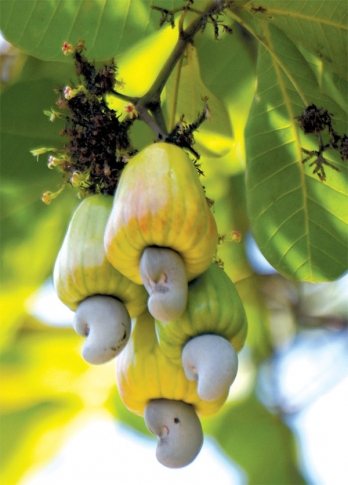
Dolcy D’Cruz
Riding in the month of May through the villages of Goa, especially those that have still protected their green cover, one unmistakable aroma is that of a ripe cashew apple. Before the eye catches the yellow and red beauty on the tree, its distinct aroma is more inviting in the summer heat. The fruit is used for the extraction of niro which is further distilled to Urrack and finally distilled to feni. The Cashew travelled with the Portuguese from Brazil to Goa in the 16th century. The first documented record of the consumption of a cashew seed was in 1926.
It is the cashew season in Goa and this fruit provides livelihood to many Goans who survive on just the produce till the next season. There is a lot of toil that goes into making the final products of freshly roasted cashewnuts or a bottle of double distilled feni. In 2009, Cashew Feni was successfully registered as Geographical Indication (GI) and granted the certificate for registration under the Geographical Indication
Act 1999, which falls in class 33 for Alcoholic Beverages and registered under GI No. 120. Following this, nine
other Goan products were registered including the Goan cashew in 2023.
The right education for the young is important to produce a high yield even with change in climatic conditions and learning about the right measures to prevent infestations and diseases of the plantations. Don Bosco College of Agriculture (DBCA), Sulcorna, was the first educational institute in 2015, to take the cashew tree to the students. Now known as Goa College of Agriculture, Ella, Old Goa, it still provides a comprehensive syllabus on the fruit. Now even some higher secondary schools are also having courses related to agriculture.
Dr Adavi Rao Desai, former Principal scientist (Horticulture), Indian Council of Agricultural Research (ICAR) identified Goa-1 (Balli-2), Tiswadi-3 (Goa Cashew-2), Ganje-2 and KN-2/98 as promising selections for commercial cultivation in Goa state. He says the best time to plant cashew plants is with the first rains in June and it is also important to manure the trees in August, after the heavy showers.
“ICAR mainly deals with the development of new varieties and the management of trees against infections and pests. Even the cashew apple after extracting its juice has a lot of nutritional value which can be used to make other products. After hygienically extracting the juice, the pulp can be used for producing bakery items as the pulp is nutritious and fibrous. It is important to create more awareness about the cashew crop through different courses. High secondary school syllabus usually focuses on job oriented courses but research programmes can be done on the cashew crop, processing of the cashew nut, economics and management of promoting the product which can be a great industry. There is so much value for every part of a cashew fruit and nut. Even the cashew kernels can be used to extract oil which can be used for anti-rust paints, shipbuilding, brake liners of auto mobiles and even the broken pieces of cashew kernel can be used in the confectionery industry. It is not broken pieces of a cashew nut but broken pieces of kernel too that has value,” says Dr A R Desai.
He further adds, “The cashew is an important cash crop which gives good returns if proper care is taken of the plantation. With irrigation, the plantation can give up to 30 percent higher yield. It is very important to manure the trees after the harvest, especially in the month of August which gives good returns. When planning a plantation, it is better of better to have multiple varieties of cashews as there are early, mid and late varieties which yield produce in different phases as well as some varieties that don’t get much affected with high temperatures or unseasonal rains. The farmers will not lose out on an entire yield if there are different varieties in the plantation.”
Miguel Braganza, a member of the Botanical Society of Goa says, “This year, there was a nearly 40 to 50 percent drop in cashew produce. During the season, the cashew tree bears male and female flowers. The male flowers do not give fruit. As this year more heat was felt it affected the flowers. There is no research being done on the effects of weather on the trees. Cashew is the only exported agricultural crop from Goa.”
“Goa College of agriculture offers a course which includes horticulture, which is cultivation of cashew crop, ergonomy which teaches about soil type and the required conditions for planting, entomology which deals with pest control and pathology which focuses on diseases. The biggest threat to cashew plants is Cashew Shoot and Root Borrow (CSRB),” says Miguel, who now focuses on mentoring young agriculture graduates.
Rajan Shelke, assistant professor and in-charge head of the department of Entomology at Goa College of Agriculture, Ela Farm, Old Goa informs, “At Goa College of agriculture, the students are taught about horticulture which deals with cultivation of cashews, entomology and CSRB which is responsible for the death of ten percent of the trees without proper preventive measures. In the last 5-6 years, there has been a drastic drop in the yield of the plants even though there is good flowering. The flowers have got burnt with the heat and by the infestation of the T-Mosquito bug, the plantations are dying. It is very important to get the cashew trees diagnosed early in the year. Farmers usually visit the farms between January to April, that is when the plantation gives fruit but the attack on the trees start in the rainy season and one year is enough to kill their complete tree. There is no proper monitoring technology yet and so unless the tree is visually checked for initial symptoms, it is difficult to treat the disease.”
Vrundan Parab, a professor of Agriculture at Sharada Higher Secondary School, Ozarim, Pernem says, “I teach my students about cashews, its origins, soil and climate requirement, layout of cashew plantations, disease and pest control. Just like most high secondary schools have Arts, Science and Commerce stream, Sharada Higher Secondary School offers Agriculture as a stream. Many students opt for Horticulture as a subject in class 11 and 12. Since the school is based in the Pernem taluka, there are many students who have cashew plantations. They come from families who have been working with cashews for generations and they are curious to learn about the cashew. Their parents too want to know how to care for the trees and they bring their problems to the school for answers through research. Students come with questions about pest control and how best to increase the yield for the season.”
With curious minds and the eagerness of learn more about this cash crop, Goa has a bring future for cashew plantations, if preventive measures are taken to increase the yield, promising new innovative ways to brand the humble fruit.
